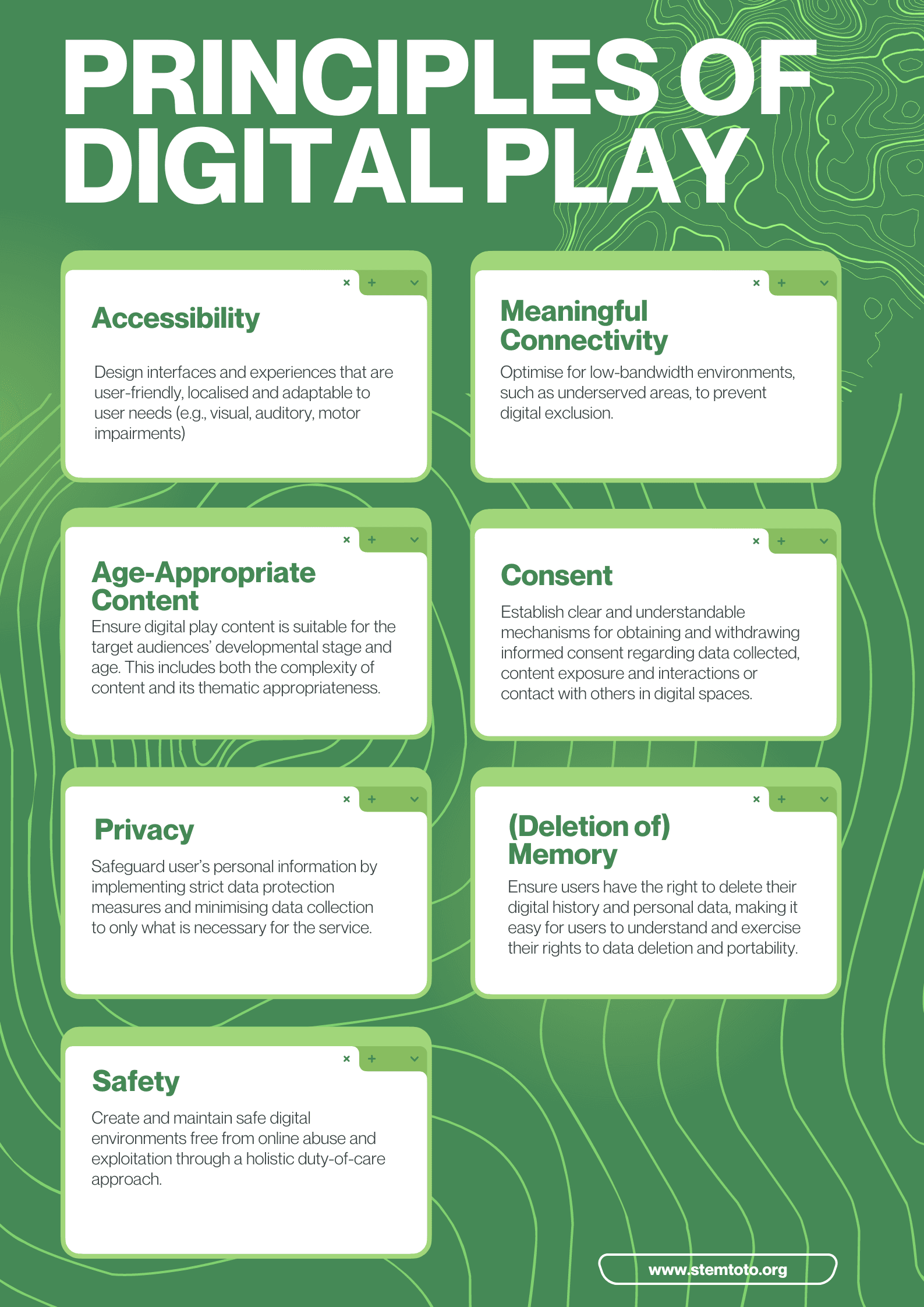
The following principles are designed to guide game developers in creating digital experiences that prioritise the well-being, safety and happiness of users. They are developed to maintain the autonomy and power of players, while minimising potential harms and exclusions.
As we conceptualise and build our games at STEMtoto, we aim to attract both long-time players and those who have not traditionally been the target market for various types of digital games. This may be due to several factors, including a lack of devices, limited or expensive internet connectivity, unfamiliarity with available games, a dearth of games that suit their tastes and preferences, insufficient localisation efforts, and gendered stereotypes regarding who can and should play digital games.
Undoubtedly, many of these challenges may be difficult to overcome or respond to, particularly from the standpoint of game design and development. Nonetheless, by reimagining these challenges as opportunities during the game design process, we can potentially create games that are more inclusive, safe, and enjoyable.
To reach audiences fitting these diverse categories, we have identified the key ingredients necessary for a game to overcome as many of these barriers as possible. We have outlined seven Principles of Digital Play. Each principle is accompanied by a brief explanation and a set of questions designed to help us evaluate our adherence to that principle.

Accessibility
Design interfaces and experiences that are user-friendly, localised and adaptable to user needs (e.g., visual, auditory, motor impairments)
Is the interface intuitive and easy to navigate for users of varying technical skills?
Are there options for adjusting text size, contrast, and colour schemes to aid those with visual impairments?
Does the game offer subtitles or closed captions for all spoken dialogue and sound effects?
Are there visual cues for important sound-based elements, like alarms or character actions?
Have we translated and localised the game content into the languages spoken by our target audience?
Have we included features like pause and save options to accommodate different play styles and needs?
Are we actively seeking feedback from players with disabilities to understand their experiences and identify areas for improvement?
(Meaningful) Connectivity
Optimise for low-bandwidth environments, such as underserved areas, to prevent digital exclusion.
Is the game designed to function smoothly in low-bandwidth environments?
Have we minimised the game's data requirements to accommodate users with limited internet access?
Are there mechanisms in place to handle intermittent connectivity without disrupting the user experience?
Does the game offer offline modes or features that allow play without a constant internet connection?
Can users download content in advance to reduce the need for continuous data usage?
(Age-appropriate) Content
Ensure digital play content is suitable for the target audiences’ developmental stage and age. This includes both the complexity of content and its thematic appropriateness.
Is the content tailored to the cognitive and emotional development of the target age group?
Have we considered the literacy and comprehension levels of our target audience in the game's design and language?
Are the themes and topics presented in the game suitable for the target audience’s age and maturity level?
Have we avoided content that could be considered inappropriate or harmful for the target age group?
Where appropriate, have we included parental controls and guidelines to help caregivers manage their children's game use?
Where appropriate, does the game provide educational benefits or developmental support suitable for the target age group?
Consent
Establish clear and understandable mechanisms for obtaining and withdrawing informed consent regarding data collected, content exposure and interactions or contact with others in digital spaces.
Are the mechanisms for obtaining consent within the game clearly explained in simple, understandable language?
Are users fully informed about what data will be collected, how it will be used, and who it will be shared with?
Is there an easy and straightforward process for users to withdraw their consent at any time?
Are we adhering to data protection regulations and standards relevant to our users' regions?
Privacy
Safeguard user’s personal information by implementing strict data protection measures and minimising data collection to only what is necessary for the service.
Are we collecting only the essential data necessary for the service to function effectively?
Have we implemented robust security protocols to protect user data from unauthorised access, breaches, or leaks?
Are users provided with clear options to control their data, including viewing, editing, or deleting their information?
Have we set clear policies on data retention, ensuring that personal information is not kept longer than necessary?
Are we limiting third-party access to user data to only those necessary for the service
(Deletion of) Memory
Ensure users have the right to delete their digital history and personal data, making it easy for users to understand and exercise their rights to data deletion and portability.
Have we clearly communicated users' rights to delete their digital history and personal data?
Is the information about data deletion and portability presented in an understandable and accessible manner?
Have we made it straightforward for users to request the deletion of their personal data and digital history?
Do we have a defined timeline for completing data deletion requests?
Have we implemented mechanisms that allow users to easily export and transfer their personal data?
Are we using secure methods to ensure that deleted data is irrecoverable and properly removed from all storage systems?
Safety
Create and maintain safe digital environments free from online abuse and exploitation through a holistic duty-of-care approach.
Are we considering safety in design, development, content moderation, and community management, where relevant?
Have we established policies and measures to prevent online abuse, harassment, and exploitation within our digital platforms?
Are there clear guidelines for appropriate behaviour and consequences for violating these guidelines?
Have we implemented user-friendly mechanisms for reporting abusive or harmful content, behaviour, or interactions?
Are reports handled promptly and effectively, with appropriate follow-up actions taken?
Are we creating a supportive and inclusive community where users feel safe to engage and express themselves, as they are, within the community guidelines?
Do we participate in industry initiatives and share best practices to promote a safer online environment for all users?
Download the PDF here.
Last Updated:
June 3, 2024





